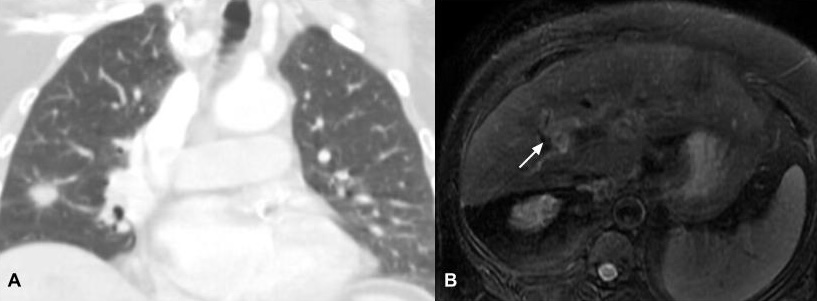Sunday Poster Session
Category: Biliary/Pancreas
P0225 - An Unexpected Primary: Intrahepatic Cholangiocarcinoma Discovered During Lung Nodule Evaluation
Sunday, October 26, 2025
3:30 PM - 7:00 PM PDT
Location: Exhibit Hall
.jpeg.jpg)
Anudeep Jala, DO (he/him/his)
Jefferson Health
Voorhees, NJ
Presenting Author(s)
Anudeep Jala, DO1, Daniel Moodey, DO2, Sachin Prasad, DO3, Seth Lipshutz, DO4, Richard Walters, DO5
1Jefferson Health, Voorhees, NJ; 2Jefferson Health, Somerdale, NJ; 3Jefferson Health, Blackwood, NJ; 4Jefferson Health, Cherry Hill, NJ; 5Jefferson Health, Sewell, NJ
Introduction: Cholangiocarcinoma (CCA) is a malignancy of the bile duct epithelium, classified based on its anatomic location into intrahepatic (iCCA), perihilar (pCCA), and distal (dCCA) subtypes. iCCA represents an uncommon subtype, accounting for approximately 10% of all CCA cases. While the incidence of extrahepatic CCA has remained stable, iCCA incidence has been rising in the United States. We present a case of intrahepatic cholangiocarcinoma initially discovered during the evaluation of a pulmonary nodule.
Case Description/
Methods: A 70-year-old woman with a medical history of hypertension, hyperlipidemia, and type 2 diabetes mellitus presented for evaluation of a persistent cough. Computed tomography (CT) scan of her chest identified a 1.9 cm spiculated mass in the right lung and a tubular soft tissue density within the right intrahepatic biliary system, raising concern for primary biliary malignancy. A positron emission tomography (PET) scan revealed hypermetabolic activity in both the hepatic and pulmonary lesions. Biopsy of the lung mass with immunohistochemical analysis was positive for cytokeratin 7 (CK7) and caudal type homeobox 2 (CDX-2). These findings were suggestive of metastasis from a gastrointestinal or pancreaticobiliary primary. Magnetic resonance imaging (MRI) of the abdomen confirmed an intrahepatic cholangiocarcinoma measuring 4.6 x 2.5 x 6.1 cm with associated metastatic portocaval lymphadenopathy. The patient was started on systemic chemotherapy with a combination of cisplatin, gemcitabine, and durvalumab.
Discussion: Intrahepatic cholangiocarcinoma is a relatively rare cancer that is characterized by its aggressive behavior and poor prognosis, often secondary to late-stage diagnosis. Advanced disease stages may preclude surgical resection, making chemotherapy and radiation therapy the primary treatment. Risk factors contributing to its rising incidence include chronic liver diseases (e.g., Hepatitis C, primary sclerosing cholangitis), diabetes, obesity, and tobacco use. The increasing incidence of iCCA in Western populations may reflect the rising prevalence of these underlying risk factors. This case underscores the importance of maintaining a high index of suspicion and ensuring timely diagnosis and management in patients with atypical presentations, particularly those with known metabolic or hepatic risk factors.

Figure: Figure 1: (A) CT chest revealing a 1.9 cm spiculated mass in the right lung, (B) Abdominal MRI demonstrating intrahepatic cholangiocarcinoma with metastatic portocaval lymphadenopathy.
Disclosures:
Anudeep Jala indicated no relevant financial relationships.
Daniel Moodey indicated no relevant financial relationships.
Sachin Prasad indicated no relevant financial relationships.
Seth Lipshutz indicated no relevant financial relationships.
Richard Walters indicated no relevant financial relationships.
Anudeep Jala, DO1, Daniel Moodey, DO2, Sachin Prasad, DO3, Seth Lipshutz, DO4, Richard Walters, DO5. P0225 - An Unexpected Primary: Intrahepatic Cholangiocarcinoma Discovered During Lung Nodule Evaluation, ACG 2025 Annual Scientific Meeting Abstracts. Phoenix, AZ: American College of Gastroenterology.
1Jefferson Health, Voorhees, NJ; 2Jefferson Health, Somerdale, NJ; 3Jefferson Health, Blackwood, NJ; 4Jefferson Health, Cherry Hill, NJ; 5Jefferson Health, Sewell, NJ
Introduction: Cholangiocarcinoma (CCA) is a malignancy of the bile duct epithelium, classified based on its anatomic location into intrahepatic (iCCA), perihilar (pCCA), and distal (dCCA) subtypes. iCCA represents an uncommon subtype, accounting for approximately 10% of all CCA cases. While the incidence of extrahepatic CCA has remained stable, iCCA incidence has been rising in the United States. We present a case of intrahepatic cholangiocarcinoma initially discovered during the evaluation of a pulmonary nodule.
Case Description/
Methods: A 70-year-old woman with a medical history of hypertension, hyperlipidemia, and type 2 diabetes mellitus presented for evaluation of a persistent cough. Computed tomography (CT) scan of her chest identified a 1.9 cm spiculated mass in the right lung and a tubular soft tissue density within the right intrahepatic biliary system, raising concern for primary biliary malignancy. A positron emission tomography (PET) scan revealed hypermetabolic activity in both the hepatic and pulmonary lesions. Biopsy of the lung mass with immunohistochemical analysis was positive for cytokeratin 7 (CK7) and caudal type homeobox 2 (CDX-2). These findings were suggestive of metastasis from a gastrointestinal or pancreaticobiliary primary. Magnetic resonance imaging (MRI) of the abdomen confirmed an intrahepatic cholangiocarcinoma measuring 4.6 x 2.5 x 6.1 cm with associated metastatic portocaval lymphadenopathy. The patient was started on systemic chemotherapy with a combination of cisplatin, gemcitabine, and durvalumab.
Discussion: Intrahepatic cholangiocarcinoma is a relatively rare cancer that is characterized by its aggressive behavior and poor prognosis, often secondary to late-stage diagnosis. Advanced disease stages may preclude surgical resection, making chemotherapy and radiation therapy the primary treatment. Risk factors contributing to its rising incidence include chronic liver diseases (e.g., Hepatitis C, primary sclerosing cholangitis), diabetes, obesity, and tobacco use. The increasing incidence of iCCA in Western populations may reflect the rising prevalence of these underlying risk factors. This case underscores the importance of maintaining a high index of suspicion and ensuring timely diagnosis and management in patients with atypical presentations, particularly those with known metabolic or hepatic risk factors.

Figure: Figure 1: (A) CT chest revealing a 1.9 cm spiculated mass in the right lung, (B) Abdominal MRI demonstrating intrahepatic cholangiocarcinoma with metastatic portocaval lymphadenopathy.
Disclosures:
Anudeep Jala indicated no relevant financial relationships.
Daniel Moodey indicated no relevant financial relationships.
Sachin Prasad indicated no relevant financial relationships.
Seth Lipshutz indicated no relevant financial relationships.
Richard Walters indicated no relevant financial relationships.
Anudeep Jala, DO1, Daniel Moodey, DO2, Sachin Prasad, DO3, Seth Lipshutz, DO4, Richard Walters, DO5. P0225 - An Unexpected Primary: Intrahepatic Cholangiocarcinoma Discovered During Lung Nodule Evaluation, ACG 2025 Annual Scientific Meeting Abstracts. Phoenix, AZ: American College of Gastroenterology.
